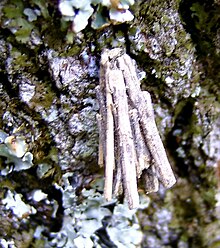Species of moth
.mw-parser-output .hidden-begin{box-sizing:border-box;width:100%;padding:5px;border:none;font-size:95%}.mw-parser-output .hidden-title{font-weight:bold;line-height:1.6;text-align:left}.mw-parser-output .hidden-content{text-align:left}@media all and (max-width:500px){.mw-parser-output .hidden-begin{width:auto!important;clear:none!important;float:none!important))You can help expand this article with text translated from
the corresponding article in Norwegian. (May 2022) Click [show] for important translation instructions.
View a machine-translated version of the Norwegian article.
Machine translation, like
DeepL or
Google Translate, is a useful starting point for translations, but translators must revise errors as necessary and confirm that the translation is accurate, rather than simply copy-pasting machine-translated text into the English Wikipedia.
Consider
adding a topic to this template: there are already 335 articles in the
main category, and specifying|topic= will aid in categorization.
Do not translate text that appears unreliable or low-quality. If possible, verify the text with references provided in the foreign-language article.
You must provide
copyright attribution in the
edit summary accompanying your translation by providing an
interlanguage link to the source of your translation. A model attribution edit summary is Content in this edit is translated from the existing Norwegian Wikipedia article at [[:no:Psyche crassiorella]]; see its history for attribution.
You may also add the template ((Translated|no|Psyche crassiorella)) to the
talk page.
For more guidance, see
Wikipedia:Translation.
Psyche crassiorella is a moth of the Psychidae family. It is found from the coasts of the Mediterranean Sea, through the temperate areas of Europe, to England and north to central Fennoscandia. In the Alps it is found up to heights of 1,200 meters.
Description
There is strong sexual dimorphism in the adults. Males have wings with a wingspan of 14–16 mm, but females are wingless.In the male the forewings are rather
broad, the apex tolerably obtuse ; dark fuscous, purplish -tinged.Hindwings rather dark fuscous. Female with anal tuft grey-whitish. Larva light purplish-brown ; subdorsal and spiracular lines on 2-4 reddish, head light brown, blackish-marked : case covered with longitudinally
placed fragments of grass; on grass, etc.[1]
Biology
Adults are on wing from May to July. There is one generation per year.
The larvae feed on various grasses, Bryophyte and Chlorophyta species and lichen as well as Geranium sanguineum.
The female moth rests with the body strongly bent under, so that the ovipositor is directed forwards.
